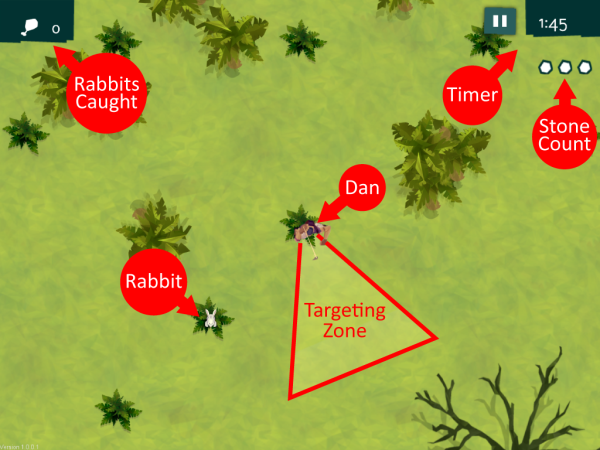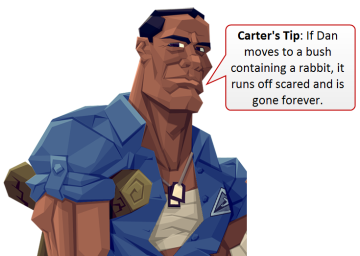

Hunt Activity
The goal of Hunt is to locate and catch as many rabbits as possible before the allotted time expires or three misses occur. Continuously scan the environment for prey and carefully plan your next jump from bush to bush.

Dan must successfully catch the rabbits that live in burrows covered by bushes because these rabbits are the primary source of food for the crew. With an overhead view of terrain and armed with a sling, Dan searches the terrain for rabbits. Dan must move close enough to catch his prey, without scaring them away. He moves by jumping from bush to bush. While Dan looks for rabbits, he rotates counterclockwise. As levels increase, the speed of rotation increases, making the challenge of hitting rabbits more difficult.
To successfully capture a rabbit:
1. Move Dan within throwing range (i.e. inside the targeting cone) of a bush that contains a rabbit.
2. Throw a stone at the rabbit as soon as it falls into the targeting cone. If the stone makes contact with the rabbit, Dan automatically runs forward to collect his catch.
The player has a limited amount of time to search for rabbits before the game ends. While Dan moves from bush to bush looking for rabbits, he rotates counterclockwise. Dan must time slinging his stone to coincide with a rabbit falling into the targeting cone. If Dan throws a stone at a rabbit and misses, he will lose that stone . If Dan runs onto a bush where a rabbit is located, the rabbit will run away, never to be seen again. Each rabbit caught is worth three food that Dan uses to feed himself, Rusty, and Books.
Each level has two stages. As levels increase, the speed of rotation increases, making the challenge of hitting rabbits more difficult.
Movement – Tap a bush on the screen and Dan moves directly to that bush.
Throw Spear– Tap Dan to throw a stone as the targeting cone revolves. A successful catch occurs when Dan throws a stone to coincide with a rabbit falling into the targeting cone.
Dan can jump from bush to far away bush, there is no limit on how far he can jump.
The terrain is set out in a grid-like fashion, ensuring the distance between rabbits and Dan is exactly the same for each bush to rabbit distance. The grid has a diamond shape (with points extending diagonally from the center).
The Terrain itself has no effect on progression and does not affect the gameplay directly in any way, including how it relates to bushes and rabbits. However, the area grid can cover a good deal of ground, requiring the player to explore a large distance. Terrains vary from grass and trees to swamps, amber fields, etc.
The player may have difficulty with the following:
The difficulty level increases with the number of:
The Hunt game challenges executive functions, attention. and perceptual motor skills by measuring how well the player moves about the terrain catching rabbits.
| Domain | SubDomain | Measurement or Challenge |
| Executive Functions | Organization | Organization Efficiency is the number of rabbits caught in relation to the number of moves the player made. The fewer moves it takes to catch all rabbits the more organized and efficient the player. The lower the number the better the score. This measure of organization is based on Mateer's Model of Executive Function and captured from the Hunt mini-game. |
| Processing Efficiency | Throughput is the number of rabbits caught in the time used reported as units/min (processing efficiency is measured using throughput). The higher the number the better the score. This measure of processing efficiency is based on BMGC's Model of Executive Function and captured from the Hunt mini-game. | |
| Visual Spatial Working Memory | Out of all the rabbits shown in this attempt, Working Memory Accuracy is the percentage of rabbits the player does not scare away. Players must remember the location of the rabbits they have seen in the bushes. The higher the number, the better the score. This measure of working memory is based on the Baddeley-Hitch Model of Working Memory and captured from the Hunt mini-game. | |
| Perceptual Motor Skills | Coincident Timing | Aiming is the coincident timing success rate, the percentage of successful stone throws. The higher the number (e.g. closer to 100) the better the performance. Aiming scores are reported for each round (e.g. Round 1 and Round 2) and the mean of both rounds is reported in the summary column. This measure of coincident timing is based on the Goodgold-Edwards description of coincidence anticipation (CA), "coincident timing is a form perceptual motor skill requiring synchronization of a movement with the arrival of a stimulus at a designated target", and captured from the Gather mini-game. |